#Learning Styles
Explore tagged Tumblr posts
Text
Bai Zhan Learning Style
I think Liu Qingge did teach his students
Wordlessly. Probably with gestures the students recognized, but a narrator like SQQ didn't. To him, it just looked like he was beating them up.
A teaching style so completely opposite to the modern schooling that SQQ wouldn't have registered it as teaching. A teaching style that would never work to teach SQQ anything, but would be great for some types of kids that fall through the cracks of the modern educational system.
Kids who worked better with a more traditional classroom style would hate it, but that doesn't matter, because everyone on Bai Zhan is there by choice.
#starchbean#mxtx#svsss#scum villain#the scum villain's self saving system#liu qingge#Bai Zhan Peak#learning styles
297 notes
·
View notes
Text

Learning : "Turn pages, turn ideas into reality"
Discover your own Learning Style!
What's your learning style here?
1. Auditory Learning - A learning style through listening to someone and processing that idea.
2. Visual Learning - A learning style that is using images, figures, diagrams, and videos to understand the idea they are pertaining to.
3. Interpersonal Learning - A learning style with group of people to share a lot of information and combine it as one.
4. Intrapersonal Learning - It is a learning style that gives you solitude to give yourself time to learn things alone.
5. Verbal Learning - A learning style that uses a voice to communicate your ideas that is very efficient and effective for everyone.
Choose what describes yourself above!
My least preferred learning style: Kinesthetic
Unlike other people, I don't like too much movement when studying. In fact, it distracts me to stay focused and attentive in doing my work.
Learning with my partner:
It's actually very effective that I have someone to share my ideas and information with. I feel heard and seen with someone that I'm close with and have the same learning style.
Infographic Source : Canva
Blue & Brown Multicolor Marine Life Eco Conservation Informational Infographic: https://www.canva.com/design/DAGeIbEmBWA/gefsGA38taIzgbW_0ZzRNQ/edit?utm_content=DAGeIbEmBWA&utm_campaign=designshare&utm_medium=link2&utm_source=sharebutton
Learning styles :
https://en.m.wikipedia.org/wiki/Learning_styles
Wanna get to know yourself deeper? Comment now, and let's help each other here! ☺️
7 notes
·
View notes
Text
Prompt 2: Describe your ideal role of environmental interpreter. What might it entail? Where might it be? What skills might you need? (Keep these all-in mind as you begin to work on your assignments – tailor these to that ideal job!)
An environmental interpreter’s job is to convey information about the environment in a way that enhances the visitor’s experience. It is crucial for the interpretation to be entertaining for visitors while also being informative. A useful skill for making interpretations engaging is having a good sense of humour and maintaining a light-hearted tone. A skilled interpreter should be able to present typically dry or complex facts in ways that appeal to visitors’ humour, imagination, or emotions when appropriate. If the interpreter is truly passionate about the material they are presenting, they should be able to tap into their emotions and use them to connect with their audience. For instance, when discussing the discovery of a new species, presenting the information in an excited and enthusiastic manner would be the most appropriate. Conversely, if the topic is the negative impacts of climate change, adopting a more sombre and reflective tone would be fitting. Knowing when each tone is appropriate and being able to effectively convey these emotions to an audience is an essential skill for any nature interpreter.
Another important skill for nature interpreters is the ability to pivot when necessary. When working with the general public, interpreters may encounter visitors who disagree with the information being presented. This can create tension among visitors or even between the interpreter and a visitor. In these situations, it is important to remain calm and redirect the conversation toward a more neutral topic. To avoid potential conflict, it is often best to steer clear of controversial topics such as politics or religion. Another instance where pivoting can be helpful is when a visitor does not understand the content being presented. While some visitors may openly express confusion, others may not voice their misunderstandings. In such cases, it is important for the interpreter to pay attention to visitors’ body language and non-verbal cues. For example, if a visitor appears confused or distracted, it may be a sign that the interpreter should adjust their approach or presentation style.
Changing the way content is presented can also be helpful since people have different learning styles. Some visitors may prefer to learn through visual aids such as images or videos, while others might benefit more from audio explanations or hands-on experiences. This is why employing a variety of interpretive methods is important for expanding the audience and making the content accessible to as many people as possible. Nature interpreters can connect with audiences through various formats, including podcasts, blog posts, videos, infographics, and, of course, in-person experiences in nature. Each location has its own advantages and disadvantages and may appeal to different learning preferences. In the end, being a successful nature interpreter requires a combination of kindness, passion, and empathy. These qualities ensure that every visitor’s experience is meaningful, enjoyable, and impactful, helping them to develop their own connection with the natural world.
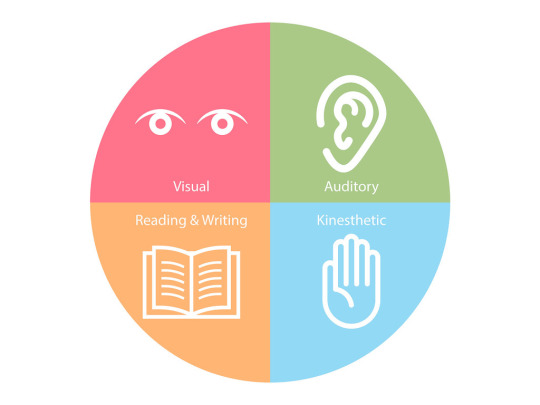
Illustration of four learning styles: visual, auditory, reading & writing, and kinesthetic. Image courtesy of Preply, licensed under CC BY 2.0.
12 notes
·
View notes
Text
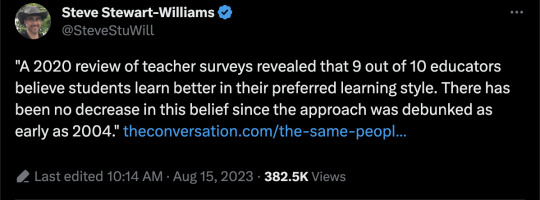
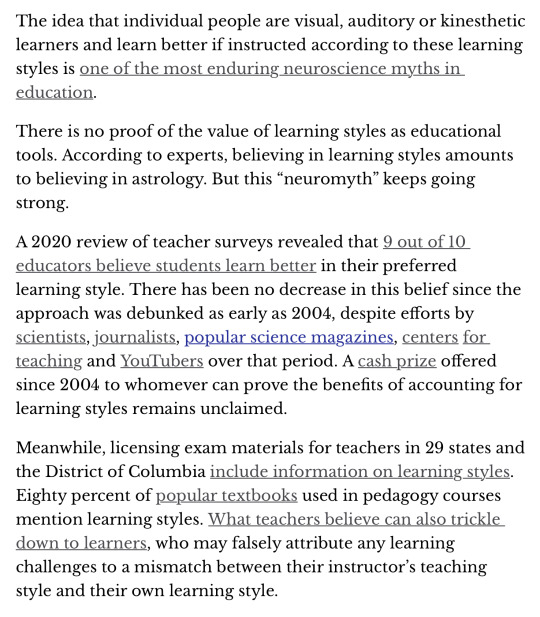
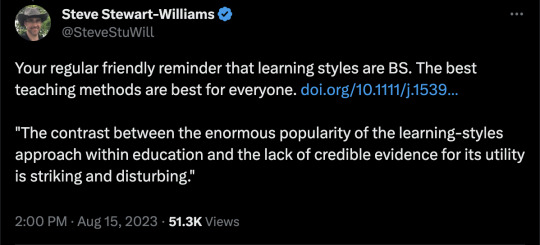
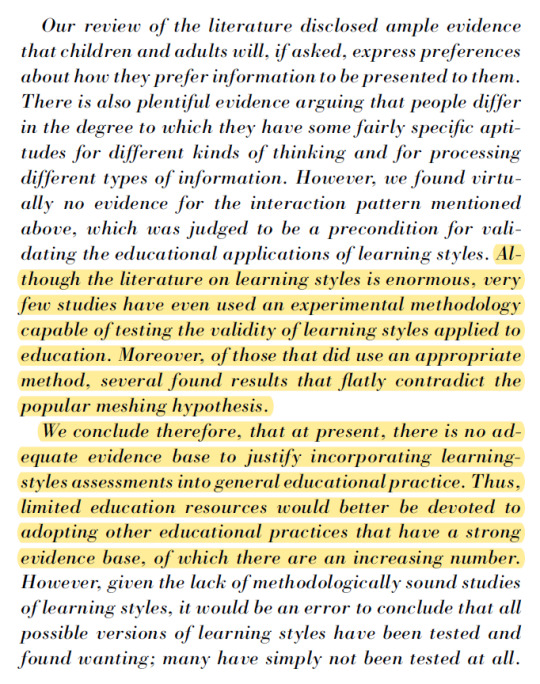
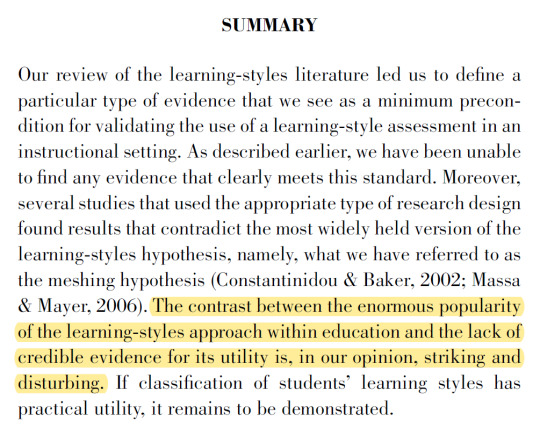
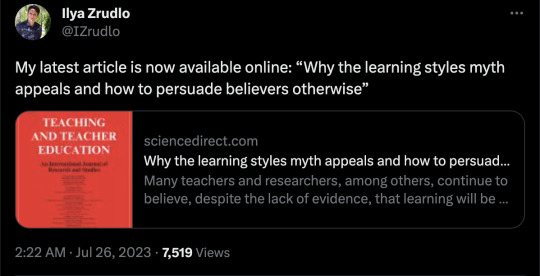
Abstract Many teachers and researchers, among others, continue to believe, despite the lack of evidence, that learning will be more effective if educators match their teaching approaches to students’ alleged learning styles. Scholars have called for more research on why the belief in learning styles is so appealing. This conceptual paper suggests four moral intuitions or sensibilities that underlie the appeal: (1) the desire for rational control, (2) our sense of justice, (3) the feeling that everyone is unique, and (4) reverence for the natural. Speaking to these intuitions could strengthen efforts to debunk the myth of learning styles in teacher education.
[..] Experts aren’t sure how the concept spread, but it might have had something to do with the self-esteem movement of the late ‘80s and early ‘90s. Everyone was special—so everyone must have a special learning style, too. Teachers told students about it in grade school. “Teachers like to think that they can reach every student, even struggling students, just by tailoring their instruction to match each student’s preferred learning format,” said Central Michigan University’s Abby Knoll, a PhD student who has studied learning styles. (Students, meanwhile, like to blame their scholastic failures on their teacher’s failure to align their teaching style with their learning style.)
Either way, “by the time we get students at college,” said the Indiana University professor Polly Husmann, “they’ve already been told ‘You’re a visual learner.’” Or aural, or what have you.
The thing is, they’re not. Or at least, a lot of evidence suggests that people aren’t really one certain kind of learner or another. In a study published last month in the journal Anatomical Sciences Education, Husmann and her colleagues had hundreds of students take the Vark questionnaire to determine what kind of learner they supposedly were. The survey then gave them some study strategies that seem like they would correlate with that learning style. Husmann found that not only did students not study in ways that seemed to reflect their learning style, those who did tailor their studying to suit their style didn’t do any better on their tests.
Husmann thinks the students had fallen into certain study habits, which, once formed, were too hard to break. Students seemed to be interested in their learning styles, but not enough to actually change their studying behavior based on them. And even if they had, it wouldn’t have mattered.
“I think as a purely reflective exercise, just to get you thinking about your study habits, [Vark] might have a benefit,” Husmann said. “But the way we’ve been categorizing these learning styles doesn’t seem to hold up.”
Another study published last year in the British Journal of Psychology found that students who preferred learning visually thought they would remember pictures better, and those who preferred learning verbally thought they’d remember words better. But those preferences had no correlation to which they actually remembered better later on—words or pictures. Essentially, all the “learning style” meant, in this case, was that the subjects liked words or pictures better, not that words or pictures worked better for their memories.
In other words, “there’s evidence that people do try to treat tasks in accordance with what they believe to be their learning style, but it doesn’t help them,” says Daniel Willingham, a psychologist at the University of Virginia. In 2015, he reviewed the literature on learning styles and concluded that “learning styles theories have not panned out.”
That same year, a Journal of Educational Psychology paper found no relationship between the study subjects’ learning-style preference (visual or auditory) and their performance on reading- or listening-comprehension tests. Instead, the visual learners performed best on all kinds of tests. Therefore, the authors concluded, teachers should stop trying to gear some lessons toward “auditory learners.” “Educators may actually be doing a disservice to auditory learners by continually accommodating their auditory learning style,” they wrote, “rather than focusing on strengthening their visual word skills.”
In our conversation, Willingham brought up another study, published in 2009, in which people who said they liked to think visually or verbally really did try to think that way: Self-proclaimed visualizers tried to create an image, and self-proclaimed verbalizers tried to form words. But, there was a rub, he said: “If you’re a visualizer and I give you pictures, you don’t remember pictures any better than anyone who says they’re verbalizer.”
This doesn’t mean everyone is equally good at every skill, of course. Really, Willingham says, people have different abilities, not styles. Some people read better than others; some people hear worse than others. But most of the tasks we encounter are only really suited to one type of learning. You can’t visualize a perfect French accent, for example.
==
Considering the sources of teacher training, Ed Schools, are extremely highly ideological, the perpetuation of this "neuromyth" is probably not an accident or misunderstanding.
These are the schools that have attached quasi-religious overtones to their preferred, but ineffective, process of teaching kids to read, and have been denying evidence-based methods for decades.
#learning styles#pseudoscience#education#corruption of education#neuroscience#myths#science#VARK#visual learner#auditory learner#reading learner#kinesthetic learner#junk science#religion is a mental illness
80 notes
·
View notes
Text
I can't stress this enough. Not everyone has the capacity to study for long periods with no other stimuli. People always say that doing two things at once is bad for productivity, but as someone who has never experienced what it is like to have a "normal" brain, I can't focus without multiple stimuli.
I need people to remember that everyone has different needs. Telling people that they are studying wrong is rude, and there is no way that you know whether that works or not because you aren't the same person. If people find something that works for them, support them, and don't tell them they are wrong. All you are gonna do is make them think that they aren't allowed to adjust things to fit them. You are causing more harm than good.
#studyblr#study motivation#graduate student#business student#studying#learning#people learn differently#learning styles#studyspo#study#study however works for you#you are capable#do what works for you
30 notes
·
View notes
Text
Hi friends!!
Some of you may know I’m a psychology major, and currently I’m doing a study on how noise sensitivity and learning styles may or may not predict academic performance in undergraduate college students! This is to fulfill some requirements to earn my degree, and in order for this study to be successful, I need at least 107 participants. If any of you who are undergraduate college students are interested in participating, all it is is taking a survey to assess your noise sensitivity level, learning style, and academic performance level. No personal information is collected, there is an option to have your email recorded if you want to be entered in a drawing for 1 of 4 $25 Amazon gift cards as a thank you for participating, but this is by no means required :)
I would really appreciate it if any of you would consider taking the survey, and I will post the link to it in a few weeks when I have IRB approval to launch the study! This is completely voluntary participation and please do not feel obligated to participate, only if you want to!
#psychology#psychology major#behavioral sciences#research#psychology research#behavioral sciences research#noise sensitivity#noise sensitivity research#learning styles#learning styles research#academic performance#academic performance research#undergraduate college students#undergraduate research
27 notes
·
View notes
Text

#english in madrid#english#english language#learning languages#learning english#english as a second language#english as a foreign language#english words#learning styles
11 notes
·
View notes
Text
Discovering my Learning Style


🤔 Have you ever thought about how you learn best? How your brain takes in new ideas?
🤔 What’s your favorite way to learn?
Let me share mine!
📖 I learn visual learning. Seeing things, like reading or looking at pictures, helps me remember them. Working alone and seeing information helps me learn in a way that makes sense to me.
🙇♀️ I relate most with the intrapersonal learning style. I learn best when I work alone. Having time to think and reflect helps me understand things better. When I focus on my own, I can take my time and really get the ideas.
👫I also see how other learning styles can be helpful. Me and my partner use visual learning a lot. They learn well by seeing pictures or reading. Even though it’s different from mine, I can see how it helps them understand things better.
Keep Learning and Growing!☺️
"Finding your learning style helps you reach your potential."
Now, it’s your turn! What’s your favorite way to learn? Share it with me!
https://pin.it/4W6qd5wMr
https://images.app.goo.gl/koHeCqW9XJQtCQQ66
5 notes
·
View notes
Text
LEARNING STYLES AND MY CONNECTION TO IT
youtube
I find the kinesthetic learning style intriguing because it involves learning through physical movement. Learners who prefer this style often excel when they can engage in activities like hands-on experiments or building projects. It emphasizes how important movement is for effective learning.
The auditory learning style also stands out to me, as it focuses on learning through listening. Those who favor this style usually do well when they hear lectures or discussions, which helps them better understand and retain information. It highlights how crucial sound is in the learning process.
I relate most to the auditory learning style, as I find that I grasp information better when I listen to it. Whether it's through podcasts, lectures, or conversations, hearing information helps me understand and remember it more easily. Listening allows me to focus and make connections, making complex ideas easier to comprehend.
I see my partner’s kinesthetic learning style as highly effective. They thrive when they can engage with the material through hands-on activities, which helps them grasp concepts more thoroughly. Observing them apply what they've learned highlights how valuable physical involvement and movement can be in the learning process.
2 notes
·
View notes
Text
Supercharge Your Memory: Brain Exercises to Keep Your Mind Agile
Boost your memory and keep your mind sharp with these effective strategies and engaging activities! Learn how brain exercises, physical activity, and more can enhance your cognitive health. #MemoryBoosting #BrainHealth #CognitiveWellness
Building a Strong Memory Keeping your memory in tip-top shape gets more important as the years roll by. Giving your brain a workout with activities that keep it active can really boost your memory and mental health overall. Importance of Brain Exercise Just like your muscles need a workout, your brain craves attention too. Doing things like brain exercises can pep up your mind, ward off those…
#Aging#Brain Exercises#Brain Games#brain health#cognitive function#Cognitive Health#Elderly Care#Learning Styles#Meditation#Memory Boosting#memory improvement#Memory Loss Prevention#Memory Training#mental wellness#physical activity#Visualization
2 notes
·
View notes
Text
SOMEONE SAVE ME FROM THE LEARNING STYLES ASSESSMENT PLEASE I WANNA DIE JUST LOOKING AT IT PLEASEEEEEEEEEEE
7 notes
·
View notes
Text
*according to aphantasia.org aphantasia is "is the inability to visualize. Otherwise known as image-free thinking." the same source defines hypophantasia as "low visual imagination" meaning persons may "experience flashes or struggle to create mental images" and such persons "have described experiences almost like aphantasia". below is an image from the same source to help put things into perspective

**primarily meaning which learning style you feel most aligns with your learning methods even though you may actually use more than one. click here to learn more about the three learning styles. and click here or here to take a free online quiz to determine your learning style. if you don't have a primary learning style then you can maybe choose which is your favourite to use or which one you use most.
8 notes
·
View notes
Text
I can't really bring myself to open the Mandarin textbook and study and learn the boring basic word in boring basic sentences.
I find I'd rather try and decipher the characters on a wall of rules in archaic language shown for a few seconds in the tv series The Untamed, or what one of the series characters mutter in a tense moment.
Or read some 1000-year-old poem, which will perhaps not have a lot to do with modern language usage.
I realise I like to be the one doing the chasing in learning and a want the subject of learning to be a bit mysterious and coy and alluring.
#watching the untamed#the untamed#language learning#learning mandarin#chinese language#learning styles
18 notes
·
View notes
Text
*Raises hand*
Teachers, I've always wanted to tell you guys, not every "When will we use this." is a disenchanted, disinterested, disgruntled complaint of thinking the lesson you are teaching is pointless. Some students like me ask because it helps with association of concepts. I was a doodler in many classes, I ask because then I can doodle a concept next to the thing you're talking about, and it gave my brain a subject and reason for learning it.
Like the whole algebra thing with find x. I learned it but I never understood its application until I went to college when I started to learn how to make my own scarf patterns. I could not get the size I wanted without alot of trial and error, until someone said "Use algebra. Figure out how many stitches are in an inch, and then figure out how any stitches you need to get the width you want it." Or even when I tried to do some woodworking project that I needed to make a box that will fit a circle inside of it. Sound familiar?
Or understanding a cell sends messages and replicates and the process of cell death etc, would help me better understand how cancer works when it became relevant in my life and I could better understand why I had to take a certain medication for it. Or telling me if I learn the shape of clouds I could predict weather and spook people when I was right. Do you know how many times I have spooked my friends and family because I saw an anvil shaped nimbostratus cloud in the distance and said "Its gonna rain probably thunderstorm soon/later" And it would happen even if the weather man said it wasn't or it would be "light"? So many times, and its funny every single time.
I know you got a lot on your plate already, but just remember the same question coming out of certain student mouths isnt' to derail the lesson, its to actually associate a lesson with a real life scenario that will be useful in the future. Its an inquiry. So like...if you could phrase homework or test questions in similar fashion that would be great because I really didn't need to know why Jason needs to calculate the speed of the train when he's traveling to a nondescript location.
I would have cared much more if you gave me the same question but tell me Jason is leaving NYC to go to Syracuse for an important event, and the speed limit is 65, and he needs to travel 247 miles, and ask how much time does Jason need to plan to be on the road and if he will make it to the event if he leaves at 5am in the morning without pit stops.
#teaching#learning#school#lessons#lesson plans#chapters#test questions#homework questions#homework#tests#school tests#science#math#history#literature#real life application#real life#when will we ever use this#learning styles#inquiry
2 notes
·
View notes
Text
What Type of Language Learner Are You?
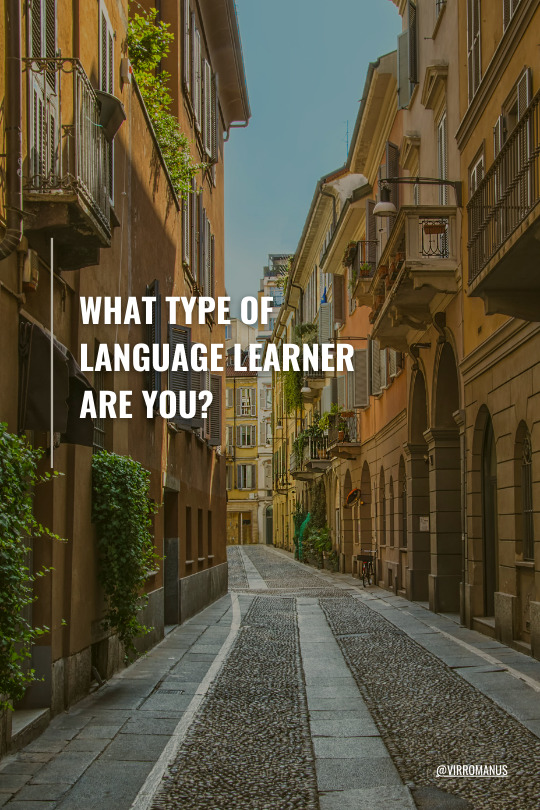
There are many ways to learn a language and you may just have your own styles and approaches in learning your target language, specifically Italian or Latin. Here are some common learning styles you might relate to:
The Social Learner: You thrive in group settings and benefit immensely from language exchanges and conversational practice. You prefer interacting with native speakers and other learners, and often use language learning as a means to make new friends.
The Analytical Learner: You love dissecting the language, understanding the rules of grammar, and building a strong foundation in the mechanics of the language. You often prefer structured lessons and enjoy the process of translating complex texts to grasp the nuances of the language. Also, you tend to ask many questions in class about the grammar rules, and sometimes, certain grammar rules may not even have a reason for their existence!
The Auditory Learner: You learn best by listening. Podcasts, songs, and dialogues are your go-to methods. Speaking and repetition play crucial roles in reinforcing your learning. If you are this type of learner, you usually excel in understanding spoken language and pronunciation. You might even pick up an accent along the way!
The Visual Learner: Visual aids like movies, flashcards, and charts are essential for you. You find visual context helpful in remembering vocabulary and grammar structures. Apps that incorporate a lot of visual learning tools are particularly appealing to them. Visualisation may help you remember new and foreign alphabets or characters easily if you put your heart and soul into learning the language.
The Kinesthetic Learner: You have the need to be physically involved in the learning process. This might involve writing out words repeatedly, using gestures to remember phrases, or moving around while reciting vocabulary. Engaging the body helps you to retain information more effectively.
The Solitary Learner: Prefers studying alone and using self-study resources. Books, apps, and online courses allow you to learn at your own pace, exploring the parts of the language that interest you the most without external pressure.
The Mixed Learner: Many learners do not fit neatly into one category but are a mix of different styles depending on their mood, the language they are learning, or their goals. If you are this type of learner, you tend to adapt your learning style to suit your needs, which can vary from one learning session to another. This versatile learning approach can be especially helpful in maintaining interest and motivation, as you're able to switch up your approach based on what feels most effective or engaging at any given time.
So, what is your language learning style?
Let us know in the comments.
#language learning#latin language#italian language#learning italian#learning latin#romance languages#language lessons#learning styles#language learner#languages#duolingo#lingQ#memrise
5 notes
·
View notes
Photo

Once you find out what type of learner you are, you can start using relevant strategies to help yourself learn better and faster
(via What type of learner are you? (infographic))
11 notes
·
View notes